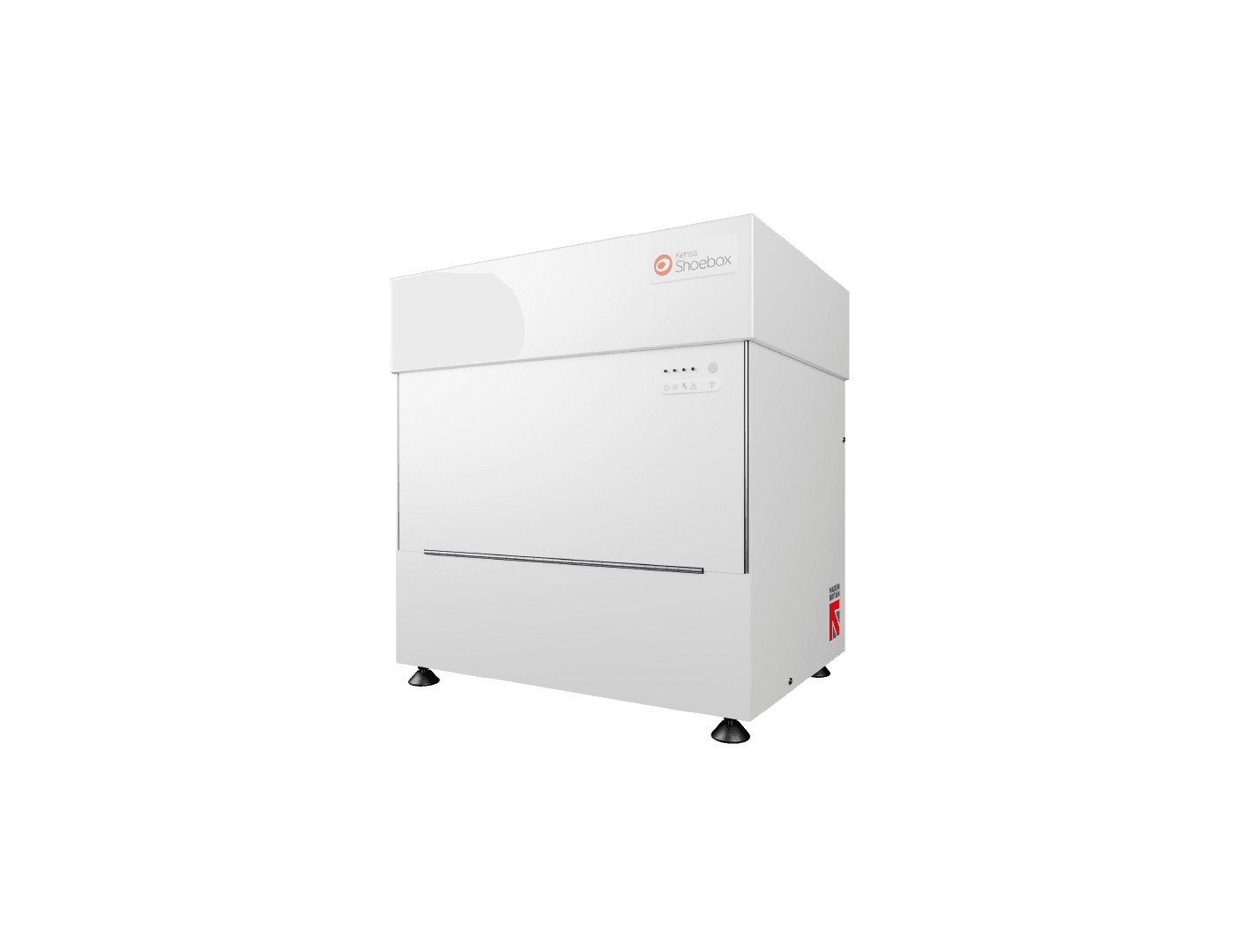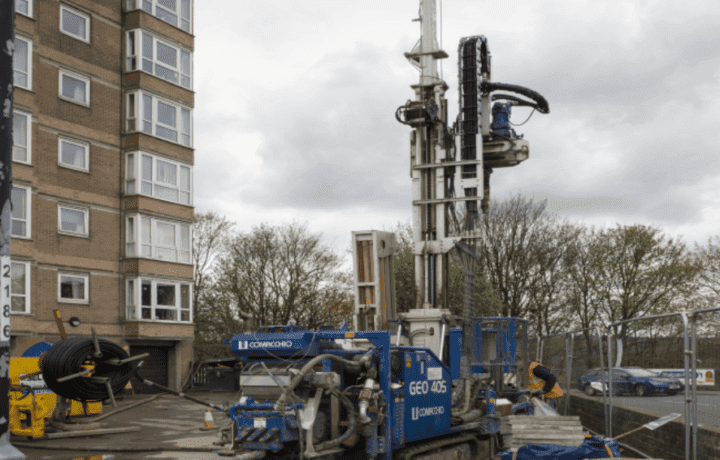Together Housing, Daisyfield
- LocationBlackburn
- SectorPublic
- Completion DateNov 2020
As part of an ongoing partnership with Together Housing Group, Kensa is in the middle of a major heat pump scheme at Daisyfield Towers – installing  What is a Ground Source Heat Pump?Ground Source Heat Pumpsground source heat pumps into 183 flats across three high-rise tower blocks in Blackburn. The scheme, which will significantly reduce carbon emissions and household heating bills, is also trialling the space-saving potential of medium-depth boreholes.
What is a Ground Source Heat Pump?Ground Source Heat Pumpsground source heat pumps into 183 flats across three high-rise tower blocks in Blackburn. The scheme, which will significantly reduce carbon emissions and household heating bills, is also trialling the space-saving potential of medium-depth boreholes.
The Daisyfield Towers are currently heated by old and obsolete gas boilers, which Together Housing is keen to decommission and replace with efficient and environmentally-friendly Kensa heat pumps. This will maintain the residents’ comfort and safety, save money on heating bills, and move away from fossil fuel reliance.
Since 2018, Kensa and Together Housing have been on a mission to tackle fuel poverty and reduce the carbon footprint of over 700 homes in the social landlord’s property portfolio. As part of this three-year programme, Kensa has already retrofitted ground source heat pumps for residents across multiple sites in Yorkshire and Lancashire. These residents are reaping the benefits of increased comfort levels and lower heating costs.
On the back of these results, Together Housing decided to expand Kensa’s schedule of works – which was already the largest of its kind in the UK to date – by adding the tower blocks at the Daisyfield site in Blackburn.
Due for completion in early 2021, the project is estimated to produce lifetime CO2 savings of 6,556 tonnes (based on SAP10 carbon factors). This equates to removing 1,416 cars from the road for a whole year, or 278,955 bags of waste being recycled instead of landfilled.¹
The installation of new ground source heat pump systems at Daisyfield is part of a £4.6million scheme of improvements that Together Housing has committed to completing in the tower blocks. This includes electrical upgrades and new safety measures, such as fire doors, fire alarms, and sprinkler systems to safeguard residents. So far, feedback from residents has been very positive, indicating they are happy that gas is being removed from their homes.
Patrick Berry, Managing Director of Together Energy Services, said:
This is a challenging and complex project combining the replacement of the heating system alongside the installation of a sprinkler system, new alarm system and upgrade of the buildings’ electrical infrastructure. All of this is being completed with the tenants in their homes. We are therefore delighted to be working with Kensa Contracting to both manage and deliver this project for the benefit of our tenants and the decarbonisation of our stock.
Individual Kensa  ShoeboxProductShoebox ground source heat pumps will be installed inside each property, linked to a radiator system, which will be upgraded where necessary. The Shoebox model is compact, quiet, and highly efficient; perfect for flats where space is at a premium, as it can be fitted inside airing cupboards or kitchen cabinets. Generating heat at the point of use, the system produces hot water temperatures up to 65ᵒC for domestic hot water and is as quiet as an average fridge freezer.
ShoeboxProductShoebox ground source heat pumps will be installed inside each property, linked to a radiator system, which will be upgraded where necessary. The Shoebox model is compact, quiet, and highly efficient; perfect for flats where space is at a premium, as it can be fitted inside airing cupboards or kitchen cabinets. Generating heat at the point of use, the system produces hot water temperatures up to 65ᵒC for domestic hot water and is as quiet as an average fridge freezer.
The Shoebox heat pumps will be linked to an array of shared ground loop boreholes – drilled underneath the green spaces and car parks adjacent to the tower blocks. The system will collect the energy from the underlying rock and distribute it at ambient temperature to the heat pumps, which will then upgrades it for use in the flats. It is also set to heat communal areas within the tower blocks, and a ground-floor café.
Kensa partner, GeniusEnergyLab, carried out extensive investigation across the three sites to determine ground conditions and thermal conductivity. The site geology was found to be made up of clay with gravel at 11m below ground level (bgl), followed by mudstone, siltstone, and sandstone at 300m bgl. At this point, coal bands were discovered and drilling could not continue below these depths due to coal authority permissions. GeniusEnergyLab then used specialist thermal modelling software to calculate the performance of the ground array to ensure the most efficient and cost-effective solution.
Chris Davidson, CEO and Technical Director of GeniusEnergyLab, commented:
It’s very exciting to be involved in this trial which will open up even the most congested of city centre locations in the UK to ground source heat pumps and all the carbon reduction and cost saving benefits they convey. This practical demonstration builds on years of modelling and installation experience from a fantastic team of companies collaborating at the cutting edge of the technology.
The borehole drilling is being carried out by expert drillers, Geodrill-Ltd, with whom Kensa has partnered with on many projects. In total, 84 boreholes will be drilled across the Daisyfield site, totalling 16,146m of boreholes. A combination of favourable ground conditions and borehole configuration offered Geodrill the opportunity to trial increasing drilling depths to 300m, as part of Kensa’s ongoing investigations into the viability of medium-depth boreholes.
Paul Turnbull, Managing Director at Geodrill, said:
We are privileged to be involved with the Daisyfield project where we drilled to 300m. Medium-depth borehole drilling is on the increase; we find ourselves being asked to drill to depths of 300m plus more frequently when the norm used to be between 100-150m deep.
It is the continued investment in equipment that makes this deeper drilling possible; with the addition of more powerful rigs and mud pumps, as well as more efficient mud cleaning systems, we are able to exploit the potential of medium-depth boreholes, creating more opportunities for ground source.
If trials in this area prove successful, it could increase the percentage of both new-build and retrofit developments that are viable for ground source. This is because projects are often ruled unsuitable if there is insufficient space to install the required number of standard depth boreholes (between 100 and 200m). Medium-depth boreholes of between 300 and 400m would allow more pipe to be installed in the ground for the same amount of ground-level surface area, increasing the amount of energy absorption possible and creating a system that can sustain a higher heat load.
Depending on the viability of the ongoing trials, over the next year, Kensa plans to work with the supply chain to develop complementary grouting and installation methods that allow regular and effective drilling of medium-depth boreholes. Watch this space.
See what residents had to say following the success of a previous  Together Housing, HalifaxCase Studyground source heat pump retrofit, proof of what’s to come at Daisyfield.
Together Housing, HalifaxCase Studyground source heat pump retrofit, proof of what’s to come at Daisyfield.
References: